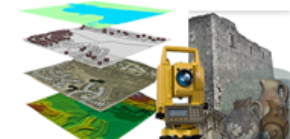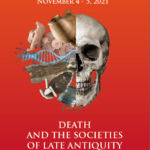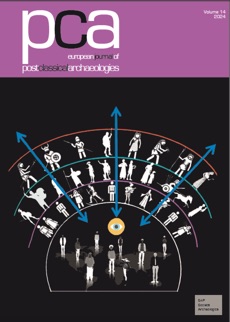International Conference
Aix-Marseille (France) – November 4–5, 2021
DEATH AND THE SOCIETIES OF LATE ANTIQUITY
New methods, new questions?
Significant developments in the methodologies used both in the field and in the laboratory have paved the way for a renewal of thinking about the populations and burial practices of Late Antiquity. Alongside work done on the period and the role of burial practices, the emergence of the area of study then known as “field anthropology” has been crucial in reshaping the focus of research. Recent studies, aided by a proliferation of archaeological examples, reveal a desire to re-examine and revise data, not only anthropological, but also archaeological and historical. These studies increase our knowledge about the treatment of the dead, the place of death among the living, the location of burial sites, and even the structure of tombs; all these elements are of course variable according to region and culture.
These recent studies, which now tend to be multidisciplinary, help us to re-examine accepted truths and to revitalize our thinking about the way in which these ancient societies envisaged Death and managed their dead in the context of the multiple changes occurring within the Roman Empire and on its margins.
Late Antiquity is marked by its political, social, economic, and cultural evolutions. This period of major societal changes initially saw the coexistence of Roman institutions and new social structures, especially those emerging from the early Christian religion. The societies of Late Antiquity are therefore characterized by a mosaic of political, social, and cultural entities, both in the heart of the Empire’s provinces and on their borders.
Can this plurality of situations also be detected in the burial practices of the period? Which elements help us to identify and define this diversity? And to what extent can burial practices really help us to understand the living conditions of ancient communities and their developments? Between the first centuries of the Roman Empire and Late Antiquity, what degree of either continuity or change in demographic and cultural dynamics do these practices reveal?
Specific reflection on the world of the dead, on a large geographic and thematic scale and in all its disciplinary plurality, has therefore become essential. Anthropology and its related sciences (biology, archaeothanatology, biochemistry) are crucial to this, alongside archaeological, historical, environmental, and societal approaches. This call for papers is for a two-day event dedicated to examining this set of questions.
Research themes for proposals may therefore include a wide range of topics, such as:
– Relationships between land ownership and land rights and the creation of burial sites.
– Expressing social identity in death.
– Detecting the plurality of cultures and communities in their perception of death, bodies, and tombs.
– Looking beyond the conceptual framework, there were a number of very specific transformations of an economic, cultural, political, or social nature. Did these changes also influence burial practices?
– Relationships between population groups in the expression of burial practices
– Populations: Composition, evolution, plurality
These themes can be approached from numerous angles, whether archaeo-anthropological, biological, historical, archaeological, topographical, or societal. We especially welcome multidisciplinary papers, whether these are synthetic or based on case studies.
The conference languages are French and English.
Proposals for oral communications or posters (in English, or in English and French) must be submitted by January 31, 2021 to mortantiquitetardive@gmail.com. Proposals must include the title of the presentation (in English, or in English and in French), a list of authors with their respective institutional affiliation and contact details, a summary (in English, or in English and in French) of 1800 characters for posters or 3000 characters for presentations, and a biography of the authors (in English, or English and French) of 1000 characters.
Oral communications will be 15 minutes long, followed by 10–15 minutes of discussion time. Accompanying PowerPoints should be in English, even for presentations that will be delivered in French. Posters are to be in English.
Organising Committee:
Gaëlle Granier (Archaeo-anthropologist, researcher, CNRS, UMR 7268 ADES), Charlotte Boyer (PhD student in Archaeo-anthropology, Université Paris 1 Panthéon-Sorbonne, UMR 7041 ArScan – UMR 7206 EAE), Elisabeth Anstett (Anthropologist, Senior Researcher, CNRS, UMR 7268 ADES).
Keynote speakers:
Alexandra Chavarria-Arnau (Università degli Studi di Padova, Padoue)
Eric Rebillard (Cornell University, New York)
Scientific committee:
Llorenç Alapont-Martin (Université de Valence, Espagne), Elisabeth Anstett (UMR 7268 ADES, Aix-Marseille Université, Marseille), Reine-Marie BÉrard (UMR 7299 CCJ, Aix-Marseille Université, Aix-en-Provence), Brigitte Boissavit-Camus (Université Paris 1 Panthéon-Sorbonne, UMR 7041 ArScan, Paris), Charlotte Boyer (Université Paris 1 Panthéon-Sorbonne, UMR 7041 ArScan – UMR 7206 EAE, Paris), Isabelle Cartron (Université de Bordeaux, UMR 5607 Ausonius, Bordeaux), Dominique Castex (UMR 5199 PACEA, Université de Bordeaux, Bordeaux), Olivier De Cazanove (Université Paris 1 Panthéon-Sorbonne, UMR 7041 ArScan, Paris), Alexandra Chavarria-Arnau (Università degli Studi di Padova, Padoue), Gaëlle Granier (UMR 7268 ADES, Aix-Marseille Université, Marseille), Sacha Kacki (UMR 5199 PACEA, Université de Bordeaux, Bordeaux), Chiara Maria Lambert (Università degli Studi di Salerno, Salerne), Nicolas Laubry (Ecole Française de Rome, Rome), Michel Lauwers (UMR 7264 CEPAM, Université de Nice-Sophia-Antipolis, Nice), Anne Nissen (Université Paris 1 Panthéon-Sorbonne, UMR 7041 ArScan, Paris), Eric Rebillard (Cornell University, New York), Pascal Sellier (UMR 7206 EAE, Musée de l’Homme, Paris).






